Iron Ore Pellets Market
Iron Ore Pellets Market Size and Share Forecast Outlook 2025 to 2035
Iron ore pellets market is projected to grow from USD 70.6 billion in 2025 to USD 128.1 billion by 2035, at a CAGR of 6.1%. Blast Furnace Grade will dominate with a 61.1% market share, while integrated steel plants will lead the end use segment with a 39.0% share.
Iron Ore Pellets Market Forecast and Outlook 2025 to 2035
The iron ore pellets market's trajectory from USD 70.6 billion in 2025 to USD 128.1 billion by 2035 represents robust expansion, the market will rise at a CAGR of 6.1% which demonstrating accelerating adoption of advanced steelmaking technologies and growing investment in metallurgical infrastructure across integrated steel plants, electric arc furnace operations, and direct reduction facilities worldwide.
The market operates within a dynamic landscape characterized by expanding steel production capacity, industrial modernization initiatives, and growing demand for high-grade iron ore feedstock across construction, automotive, infrastructure development, and manufacturing applications. Market dynamics reflect increasing investment in pelletizing plant infrastructure, accelerating adoption of environmental compliance technologies, and rising demand for efficient raw materials that support diverse steelmaking processes and production methodologies.
Quick Stats for Iron Ore Pellets Market
- Iron Ore Pellets Market Value (2025): USD 70.6 billion
- Iron Ore Pellets Market Forecast Value (2035): USD 128.1 billion
- Iron Ore Pellets Market Forecast CAGR: 6.1%
- Leading Application in Iron Ore Pellets Market: Steel Manufacturing
- Key Growth Regions in Iron Ore Pellets Market: East Asia, North America, and South America
- Key Players in Iron Ore Pellets Market: Vale S.A., Cleveland-Cliffs Inc., ArcelorMittal, Rio Tinto Group
- Where revenue comes from - Now Vs Next (Industry-level view)
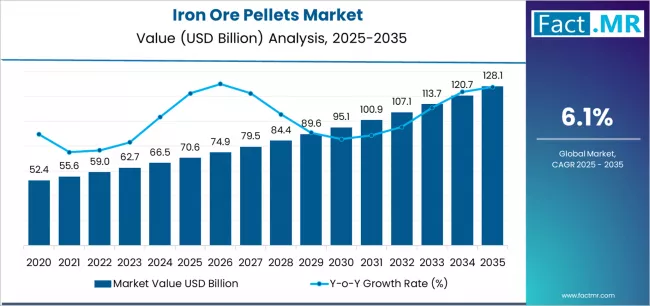
Steel industry procurement patterns demonstrate shifting preferences toward iron ore pellet systems that combine high iron content, enhanced metallurgical properties, and optimized blast furnace performance. Integrated steel plants and mini-mill operators prioritize feedstock reliability, chemical consistency, and operational efficiency when selecting raw materials for critical applications including pig iron production, direct reduction processes, steel manufacturing, and quality enhancement procedures.
The market benefits from expanding steel consumption activities across construction, automotive, and infrastructure sectors, driving demand for high-quality iron ore feedstock that enables efficient metallurgical processing procedures. Growing emphasis on environmental compliance and emission reduction creates opportunities for manufacturers offering validated pelletizing systems with comprehensive quality control and production optimization capabilities.
Technology advancement influences market evolution through integration of advanced beneficiation systems, enhanced pelletizing technologies, and automated quality control platforms that improve iron content and metallurgical performance. Manufacturers focus on developing pelletizing solutions that accommodate varying ore grades, processing conditions, and steel plant requirements while maintaining consistent chemical composition throughout extended production periods.
The iron ore pellets market demonstrates strong growth fundamentals driven by expanding steel production activities, metallurgical infrastructure development, and increasing demand for high-grade iron ore feedstock across multiple industrial sectors and manufacturing applications.
The first half of the decade (2025-2030) will witness market growth from USD 70.6 billion to approximately USD 92.4 billion, adding USD 21.8 million in value, representing 37% of the total forecast period expansion. This phase will be characterized by rapid adoption of blast furnace optimization technologies, driven by steel industry modernization programs and increasing demand for enhanced metallurgical capabilities across steelmaking applications.
The latter half (2030-2035) will experience accelerated growth from USD 92.4 billion to USD 128.1 billion, representing an addition of USD 35.7 billion or 63% of the decade's expansion. This period will be defined by mass market penetration of advanced direct reduction technologies, integration with steel plant information management systems, and seamless connectivity with existing metallurgical infrastructure.
| Period | Primary Revenue Buckets | Share | Notes |
|---|---|---|---|
| Today | Blast furnace grade pellets | 61% | Integrated steel plants, traditional steelmaking |
| Direct reduction grade pellets | 26% | Electric arc furnaces, mini-mills | |
| Steel manufacturing applications | 88% | Primary end-use market | |
| Foundry applications | 8% | Specialty casting operations | |
| Chemical applications | 4% | Iron-based chemical production | |
| Future (3-5 yrs) | Advanced blast furnace systems | 58-62% | Enhanced efficiency, emission reduction |
| Direct reduction processes | 28-32% | Green steel production, hydrogen-based reduction | |
| Steel production facilities | 85-89% | Integrated plants, electric arc furnaces | |
| Specialty applications | 6-10% | High-grade steel, precision casting | |
| Chemical & foundry sectors | 4-8% | Iron chemicals, specialized applications | |
| Export markets | 15-20% | Seaborne trade, regional distribution |
Iron Ore Pellets Market Key Takeaways
At-a-Glance Metrics
| Metric | Value |
|---|---|
| Market Value (2025) → | USD 70.6 billion |
| Market Forecast (2035) ↑ | USD 128.1 billion |
| Growth Rate ★ | 6.1% CAGR |
| Leading Application → | Steel Manufacturing |
| Primary End-Use → | Integrated Steel Plants |
The market demonstrates strong fundamentals with steel manufacturing applications capturing dominant share through advanced metallurgical capabilities and blast furnace optimization. Integrated steel plants drive primary demand, supported by increasing production activity and steel industry expansion initiatives. Geographic distribution remains concentrated in developed markets with established steelmaking infrastructure, while emerging economies show accelerating adoption rates driven by industrial modernization programs and rising steel investment.
Imperatives for Stakeholders in Iron Ore Pellets Market
Design for metallurgical precision, not just functionality
- Offer complete pelletizing systems: pellet plants + processing equipment + quality control systems + handling infrastructure + operational guides + maintenance protocols.
- Preconfigured production workflows: beneficiation processes, pelletizing operations, quality assurance systems, and performance monitoring for steel plant operations.
Steel plant integration readiness
- Real-time quality monitoring, production tracking, and smart plant integration (MES connectivity, process control systems).
Quality-by-design approach
- Advanced pelletizing plant systems, real-time performance monitoring, chemical analysis integration, and comprehensive production documentation.
Value-based pricing models
- Clear base pellet price + transparent service tiers (processing services, quality guarantees, performance assurance); contracts for supply security and price stability.
Segmental Analysis
The market segments by product grade into blast furnace grade, direct reduction grade, and specialty pellets, representing evolution from traditional iron ore concentrate to sophisticated pelletized feedstock for comprehensive steel production and metallurgical optimization.
End-use segmentation divides the market into integrated steel plants, electric arc furnace operations, direct reduction facilities, and foundry applications, reflecting distinct requirements for iron content, chemical composition, and metallurgical property specifications.
Technology segmentation covers straight-grate systems, grate-kiln processes, and traveling grate methods, while distribution channels span direct supply agreements, trading companies, and specialized raw material distributors.
Geographic distribution covers North America, South America, East Asia, South Asia Pacific, Western Europe, Eastern Europe, and Middle East & Africa, with established steel-producing regions leading adoption while developing economies show accelerating growth patterns driven by industrial development programs.
The segmentation structure reveals technology progression from traditional iron ore concentrate toward sophisticated pelletized systems with enhanced metallurgical property capabilities, while application diversity spans from basic steel production to specialized processes requiring precise chemical composition solutions.
By Product Grade, the Blast Furnace Grade Segment Accounts for Dominant Market Share
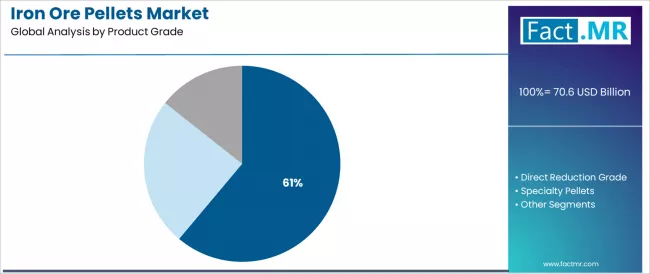
Blast furnace grade pellets command the leading position in the iron ore pellets market with 61.1% market share through proven steelmaking technologies, including enhanced iron content, reliable metallurgical properties, and production optimization that enable steel plant operators to achieve optimal blast furnace results across diverse integrated steelmaking environments.
The segment benefits from steel industry preference for high-grade raw materials that provide consistent chemical composition, operational reliability, and production flexibility without requiring extensive ore preparation. Advanced blast furnace processing features enable enhanced iron recovery, precise temperature control, and integration with existing steel plant systems, where metallurgical precision and feedstock reliability represent critical operational requirements.
Blast furnace grade applications differentiate through proven production reliability, comprehensive quality control systems, and integration with established steelmaking processes that enhance production effectiveness while maintaining optimal metallurgical standards suitable for diverse steel manufacturing applications.
Key market characteristics:
- Advanced pelletizing designs with optimized iron content and metallurgical performance capabilities
- Enhanced production effectiveness, enabling 92-95% iron recovery with consistent chemical composition
- Steel plant compatibility, including automated handling, quality monitoring, and performance tracking for blast furnace operations
Direct Reduction Grade Shows Strong Specialty Demand
Direct reduction grade applications maintain a 26.4% market position in the iron ore pellets market due to their electric arc furnace advantages and green steelmaking application benefits. These applications appeal to steel producers requiring high-purity raw materials with enhanced metallurgical profiles for mini-mill operations. Market growth is driven by electric arc furnace expansion, emphasizing environmental compliance solutions and operational excellence through optimized direct reduction designs.
By End-Use, Integrated Steel Plants Drive Market Leadership
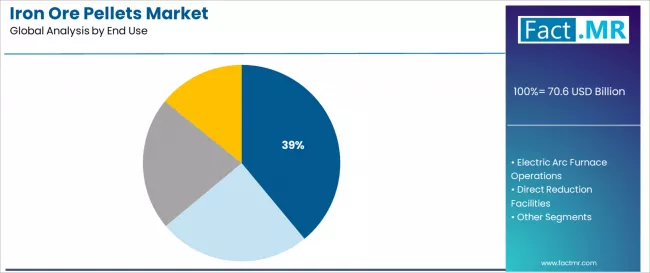
Integrated steel plants dominate the market with 6.8% CAGR, reflecting the primary demand source for iron ore pellet technology in steel production and metallurgical optimization. Integrated steel plants provide direct market demand for standardized pelletizing systems, driving volume production and cost optimization while maintaining metallurgical precision and quality consistency requirements.
Integrated steel plants include production optimization, operational efficiency, and quality assurance that drive consistent demand for pelletizing systems while providing access to latest iron ore pellet technologies. The segment is projected to capture a market share of around 39%.
What are the Drivers, Restraints, and Key Trends of the Iron Ore Pellets Market?
| Category | Factor | Impact | Why It Matters |
|---|---|---|---|
| Driver | Global steel production expansion & infrastructure development (construction, automotive, manufacturing) | ★★★★★ | Growing industrial market requires advanced raw materials with enhanced iron content capabilities and metallurgical properties proven effective across steel production applications. |
| Driver | Steel industry modernization & blast furnace optimization (integrated plants, electric arc furnaces) | ★★★★★ | Transforms raw material requirements from "basic iron ore" to "high-grade pelletized feedstock"; operators that offer advanced pelletizing systems and quality features gain competitive advantage. |
| Driver | Environmental compliance & emission reduction (green steel initiatives, carbon footprint reduction) | ★★★★☆ | Modern steel facilities need efficient, validated raw material systems; demand for clean and compliant metallurgical solutions expanding addressable market. |
| Restraint | Iron ore price volatility & supply chain disruptions (especially for smaller steel producers) | ★★★★☆ | Smaller steel facilities defer raw material upgrades; increases price sensitivity and slows advanced pellet adoption in cost-conscious markets. |
| Restraint | Alternative steelmaking technology competition (scrap-based production, electric arc recycling, other raw materials) | ★★★☆☆ | Traditional steelmaking alternatives offer established supply chains and lower costs, potentially limiting pellet adoption in conventional applications. |
| Trend | Direct reduction technology advancement & hydrogen-based steelmaking (green steel production, emission reduction) | ★★★★★ | Advanced environmental properties, production optimization, and green steelmaking transform operations; emission reduction and efficiency enhancement become core value propositions. |
| Trend | Quality control integration & automated monitoring (process control, chemical analysis, performance tracking) | ★★★★☆ | Smart pelletizing systems for specific applications and processes; specialized quality control and targeted optimization capabilities drive competition toward intelligent solutions. |
Analysis of the Iron Ore Pellets Market by Key Country
The iron ore pellets market demonstrates varied regional dynamics with growth leaders including China (7.8% growth rate) and India (7.3% growth rate) driving expansion through steel industry development and metallurgical infrastructure modernization initiatives.
Steady performers encompass Brazil (6.9% growth rate), USA (6.2% growth rate), and developed regions, benefiting from established steel facilities and industrial sector growth. Mature markets feature Germany (5.8% growth rate), UK (5.1% growth rate), and Japan (4.6% growth rate), where steel modernization and production optimization requirements support consistent growth patterns.
Regional synthesis reveals East Asian markets leading adoption through steel production expansion and industrial development, while North American countries maintain steady expansion supported by steel industry advancement and infrastructure investment. South American markets show strong growth driven by mining operations and export development trends.
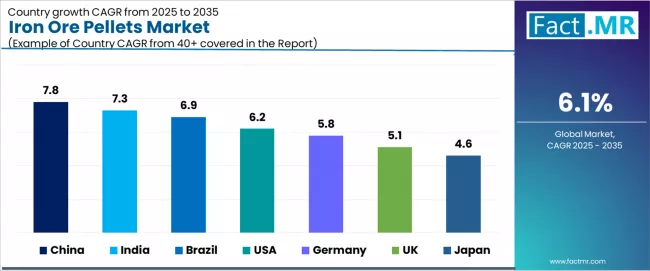
| Country | 2025-2035 Growth | How to win | What to watch out |
|---|---|---|---|
| China | 7.8% | Focus on high-grade steel solutions | Environmental regulations; overcapacity |
| India | 7.3% | Lead with integrated steel systems | Infrastructure constraints; import dependencies |
| Brazil | 6.9% | Provide export-oriented solutions | Currency fluctuations; mining regulations |
| USA | 6.2% | Push technology integration | Environmental compliance; competition |
| Germany | 5.8% | Focus on premium steel applications | Energy costs; regulatory complexity |
| UK | 5.1% | Emphasize green steel solutions | Economic impacts; supply chain challenges |
| Japan | 4.6% | Target precision steel manufacturing | Aging infrastructure; energy costs |
China Drives Fastest Market Growth
China establishes fastest market growth through aggressive steel industry development programs and comprehensive pelletizing facility expansion, integrating advanced iron ore pellet systems as standard components in integrated steel plants and electric arc furnace operations. The country's 7.8% growth rate reflects government initiatives promoting steel modernization and domestic raw material capabilities that mandate use of high-grade pelletizing systems in blast furnace and steelmaking facilities. Growth concentrates in major industrial hubs, including Beijing, Shanghai, and Guangzhou, where steel development showcases integrated pelletizing systems that appeal to steel operators seeking metallurgical optimization capabilities and production applications.
Chinese manufacturers are developing cost-effective pelletizing solutions that combine domestic production advantages with advanced iron ore processing features, including enhanced iron content and improved metallurgical capabilities. Distribution channels through steel industry suppliers and plant integrators expand market access, while government support for steel development supports adoption across diverse integrated plant and electric arc furnace segments.
Strategic Market Indicators:
- Government steel programs providing substantial funding for domestic pelletizing technology development
- Export market development for cost-effective pelletizing solutions targeting emerging steel markets
India Emerges as High-Growth Market
In Mumbai, Delhi, and Bangalore, steel facilities and industrial operators are implementing iron ore pellet systems as standard equipment for blast furnace optimization and production efficiency applications, driven by increasing government industrial investment and steel development programs that emphasize importance of high-grade raw material capabilities. The market holds a 7.3% growth rate, supported by government steel initiatives and facility modernization programs that promote advanced pelletizing systems for integrated steel and electric arc furnace facilities. Indian operators are adopting pelletizing systems that provide consistent iron content and metallurgical features, particularly appealing in urban regions where production optimization and steel excellence represent critical industrial requirements.
Market expansion benefits from growing steel capabilities and international technology partnerships that enable domestic production of advanced pelletizing systems for blast furnace and steelmaking applications. Technology adoption follows patterns established in steel equipment, where quality and performance drive procurement decisions and operational deployment.
Market Intelligence Brief:
- Steel modernization programs emphasizing pelletizing systems for production effectiveness and metallurgical excellence
- Local manufacturers partnering with international providers for pelletizing equipment development
- Steel facilities implementing pelletizing systems for production optimization and quality management
Brazil Maintains Export Leadership
Brazil's advanced steel market demonstrates sophisticated iron ore pellet deployment with documented production effectiveness in steel applications and export facilities through integration with existing mining systems and pelletizing infrastructure. The country leverages mining expertise in iron ore processing and pelletizing systems integration to maintain a 6.9% growth rate. Steel centers, including Minas Gerais, Espírito Santo, and Rio de Janeiro, showcase premium installations where pelletizing systems integrate with comprehensive mining platforms and export systems to optimize production efficiency and quality effectiveness.
Brazilian producers prioritize system quality and export compliance in pelletizing development, creating demand for premium systems with advanced features, including facility integration and quality management systems. The market benefits from established mining infrastructure and willingness to invest in advanced pelletizing technologies that provide long-term operational benefits and compliance with international steel standards.
Market Intelligence Brief:
- Mining focuses on export standardization and quality compliance, driving premium segment growth
- Technology collaboration between Brazilian producers and international pelletizing companies
- Professional training programs expanding pelletizing system integration in mining scenarios
USA Shows Strong Industrial Development
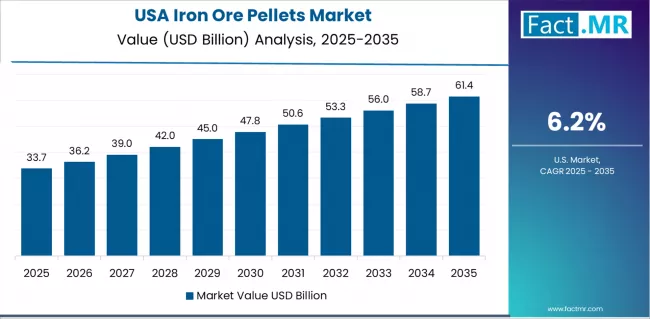
The USA' market expansion benefits from diverse steel demand, including automotive modernization in Detroit and Chicago, steel facility upgrades, and government infrastructure programs that increasingly incorporate high-grade pelletizing solutions for steelmaking applications. The country maintains a 6.2% growth rate, driven by rising steel activity and increasing recognition of pelletizing benefits, including accurate blast furnace control and enhanced production effectiveness.
Market dynamics focus on technology-integrated pelletizing solutions that balance metallurgical performance with environmental considerations important to American steel operators. Growing steel development creates continued demand for modern pelletizing systems in new steel infrastructure and facility modernization projects.
Strategic Market Considerations:
- Steel and automotive segments leading growth with focus on blast furnace control and production effectiveness applications
- Regional steel requirements driving diverse product portfolio from basic pelletizing systems to premium solutions
- Supply chain challenges offset by domestic production capabilities with integrated steel manufacturers
- Government infrastructure initiatives beginning to influence procurement standards and pelletizing requirements
Germany Maintains Technology Leadership
Germany establishes technology leadership through comprehensive steel programs and advanced industrial infrastructure development, integrating iron ore pellet systems across automotive and manufacturing applications. The country's 5.8% growth rate reflects established steel relationships and mature pelletizing technology adoption that supports widespread use of high-grade pelletizing systems in integrated steel and specialty manufacturing facilities. Growth concentrates in major steel centers, including North Rhine-Westphalia, Bavaria, and Baden-Württemberg, where metallurgical technology showcases mature deployment that appeals to steel operators seeking proven quality capabilities and production optimization applications.
German steel providers leverage established distribution networks and comprehensive technical support capabilities, including system design programs and training support that create customer relationships and operational advantages. The market benefits from mature regulatory standards and steel requirements that mandate pelletizing system use while supporting technology advancement and production optimization.
Market Intelligence Brief:
- Established regulatory standards providing consistent demand for pelletizing technology advancement
- Technology integration programs expanding pelletizing capabilities in steel scenarios
UK Shows Premium Integration
UK's steel market demonstrates integrated iron ore pellet deployment with documented quality effectiveness in steel applications and manufacturing facilities through integration with existing steel systems and production infrastructure. The country maintains a 5.1% growth rate, supported by steel efficiency programs and production effectiveness requirements that promote high-grade pelletizing systems for manufacturing applications. Steel facilities across England, Scotland, and Wales showcase systematic installations where pelletizing systems integrate with comprehensive steel platforms to optimize quality and production outcomes.
UK steel providers prioritize system reliability and manufacturing compatibility in pelletizing procurement, creating demand for validated systems with proven quality features, including performance monitoring integration and data management systems. The market benefits from established steel infrastructure and quality requirements that support pelletizing technology adoption and production effectiveness.
Market Intelligence Brief:
- Manufacturing compatibility requirements driving standardized pelletizing system adoption
- Steel partnerships providing quality validation and effectiveness data
- Technology integration between UK steel providers and international pelletizing companies
- Professional training programs expanding pelletizing system deployment in steel scenarios
Japan Shows Precision Market Development
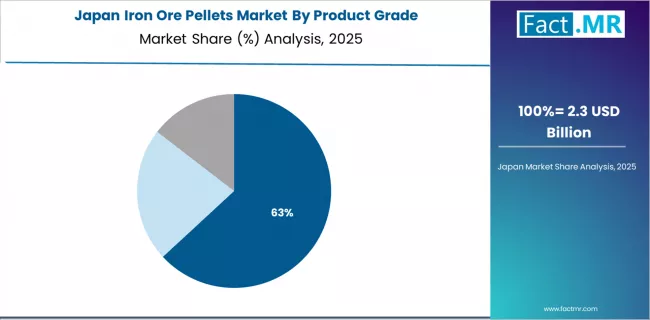
Japan's market growth benefits from precision steel demand, including advanced manufacturing facilities in Tokyo and Osaka, quality integration, and precision enhancement programs that increasingly incorporate pelletizing solutions for steel applications. The country maintains a 4.6% growth rate, driven by steel technology advancement and increasing recognition of precision pelletizing benefits, including accurate metallurgical control and enhanced production outcomes.
Market dynamics focus on high-precision pelletizing solutions that meet Japanese quality standards and steel effectiveness requirements important to manufacturing operators. Advanced steel technology adoption creates continued demand for sophisticated pelletizing systems in manufacturing facility infrastructure and production modernization projects.
Strategic Market Considerations:
- Steel and precision segments leading growth with focus on advanced pelletizing systems and quality applications
- Quality requirements driving premium product adoption from advanced pelletizing systems
- Technology integration challenges balanced by strong precision effectiveness and quality capabilities
- Manufacturing quality initiatives beginning to influence procurement standards and pelletizing requirements
Europe Market Split by Country
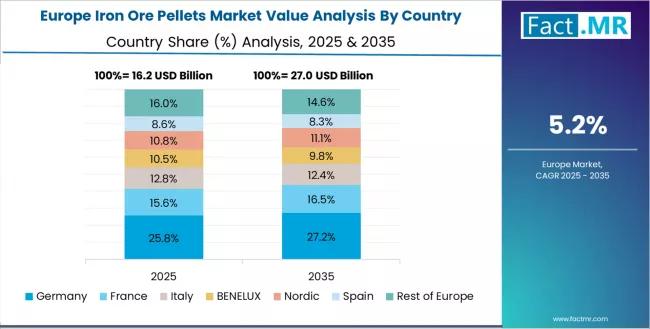
The iron ore pellets market in Europe is projected to grow from USD 16.2 billion in 2025 to USD 23.8 billion by 2035, registering a CAGR of 4.0% over the forecast period. Germany is expected to maintain its leadership position with a 34.6% market share in 2025, supported by its advanced steel infrastructure and major automotive manufacturing centers.
UK follows with a 22.1% share in 2025, driven by comprehensive steel programs and industrial development initiatives. France holds a 18.9% share through specialized steel applications and manufacturing compliance requirements. Italy commands a 12.7% share, while Spain accounts for 7.8% in 2025.
The rest of Europe region is anticipated to gain momentum, expanding its collective share from 3.9% to 4.2% by 2035, attributed to increasing steel adoption in Nordic countries and emerging manufacturing facilities implementing production modernization programs.
Competitive Landscape of the Iron Ore Pellets Market
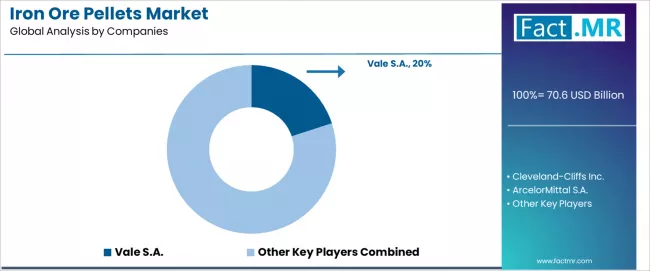
- Structure: ~20-25 credible players; top 3-5 hold ~65-70% by revenue.
- Leadership is maintained through: mining operations, processing technology, and distribution networks (iron content + consistency + supply reliability).
- What's commoditizing: basic pelletizing processes and standard iron ore concentration.
- Margin Opportunities: specialized processing services, quality enhancement, and incorporation into steel production workflows (metallurgical optimization, performance monitoring).
| Stakeholder | What they actually control | Typical strengths | Typical blind spots |
|---|---|---|---|
| Global miners | Mining reserves, broad pellet portfolios, global reach | Wide availability, proven quality, multi-region supply | Product refresh cycles; customer dependency on commodity pricing |
| Technology innovators | Pelletizing R&D; advanced processing technologies; enhanced quality properties | Latest technologies first; attractive ROI on quality effectiveness | Service density outside core regions; scaling complexity |
| Regional specialists | Local mining operations, fast delivery, nearby customer support | "Close to customer" support; pragmatic pricing; local regulations | Technology gaps; talent retention in customer service |
| Integrated producers | Complete steel supply programs, processing integration, quality monitoring | Lowest operational risk; comprehensive support | Service costs if overpromised; technology obsolescence |
| Specialty processors | Specialized applications, custom grades, premium services | Win premium applications; flexible configurations | Scalability limitations; narrow market focus |
Key Players in the Iron Ore Pellets Market
- Vale S.A.
- Cleveland-Cliffs Inc.
- ArcelorMittal S.A.
- Rio Tinto Group
- BHP Group
- Luossavaara-Kiirunavaara AB (LKAB)
- Ferrexpo PLC
- Anglo American plc
- Fortescue Metals Group Ltd.
- Metalloinvest
- Jindal Steel & Power Limited
- NMDC Limited
Scope of the Report
| Item | Value |
|---|---|
| Quantitative Units | USD 70.6 billion |
| Product Grade | Blast Furnace Grade, Direct Reduction Grade, Specialty Pellets |
| End Use | Integrated Steel Plants, Electric Arc Furnace Operations, Direct Reduction Facilities, Foundry Applications |
| Regions Covered | North America, South America, Western Europe, Eastern Europe, East Asia, South Asia Pacific, Middle East & Africa |
| Countries Covered | China, India, Brazil, USA, Germany, UK, Japan, Canada, France, Australia, and 25+ additional countries |
| Key Companies Profiled | Vale S.A., Cleveland-Cliffs Inc., ArcelorMittal, Rio Tinto Group, BHP Group, LKAB, Ferrexpo PLC |
| Additional Attributes | Dollar sales by product grade and end-use categories, regional adoption trends across East Asia, North America, and South America, competitive landscape with mining companies and steel producers, steel operator preferences for pelletizing effectiveness and quality control, integration with steel production platforms and process management systems, innovations in pelletizing technology and quality enhancement, and development of advanced processing solutions with enhanced metallurgical properties and production optimization capabilities. |
Iron Ore Pellets Market by Segments
-
Product Grade :
- Blast Furnace Grade
- Direct Reduction Grade
- Specialty Pellets
-
End Use :
- Integrated Steel Plants
- Electric Arc Furnace Operations
- Direct Reduction Facilities
- Foundry Applications
-
Technology :
- Straight-Grate Systems
- Grate-Kiln Processes
- Traveling Grate Methods
-
Region :
- North America
- USA
- Canada
- Mexico
- South America
- Brazil
- Chile
- Rest of South America
- Western Europe
- Germany
- UK
- France
- Italy
- Spain
- Nordic
- BENELUX
- Rest of Western Europe
- Eastern Europe
- Russia
- Poland
- Rest of Eastern Europe
- East Asia
- China
- Japan
- South Korea
- South Asia Pacific
- India
- ASEAN
- Australia & New Zealand
- Rest of South Asia Pacific
- Middle East & Africa
- Kingdom of Saudi Arabia
- Other GCC Countries
- Turkey
- South Africa
- Other African Union
- Rest of Middle East & Africa
- North America
Table of Content
- Executive Summary
- Global Market Outlook
- Demand to side Trends
- Supply to side Trends
- Technology Roadmap Analysis
- Analysis and Recommendations
- Market Overview
- Market Coverage / Taxonomy
- Market Definition / Scope / Limitations
- Market Background
- Market Dynamics
- Drivers
- Restraints
- Opportunity
- Trends
- Scenario Forecast
- Demand in Optimistic Scenario
- Demand in Likely Scenario
- Demand in Conservative Scenario
- Opportunity Map Analysis
- Product Life Cycle Analysis
- Supply Chain Analysis
- Investment Feasibility Matrix
- Value Chain Analysis
- PESTLE and Porter’s Analysis
- Regulatory Landscape
- Regional Parent Market Outlook
- Production and Consumption Statistics
- Import and Export Statistics
- Market Dynamics
- Global Market Analysis 2020 to 2024 and Forecast, 2025 to 2035
- Historical Market Size Value (USD Million) Analysis, 2020 to 2024
- Current and Future Market Size Value (USD Million) Projections, 2025 to 2035
- Y to o to Y Growth Trend Analysis
- Absolute $ Opportunity Analysis
- Global Market Pricing Analysis 2020 to 2024 and Forecast 2025 to 2035
- Global Market Analysis 2020 to 2024 and Forecast 2025 to 2035, By Product Grade
- Introduction / Key Findings
- Historical Market Size Value (USD Million) Analysis By Product Grade , 2020 to 2024
- Current and Future Market Size Value (USD Million) Analysis and Forecast By Product Grade , 2025 to 2035
- Blast Furnace Grade
- Direct Reduction Grade
- Specialty Pellets
- Y to o to Y Growth Trend Analysis By Product Grade , 2020 to 2024
- Absolute $ Opportunity Analysis By Product Grade , 2025 to 2035
- Global Market Analysis 2020 to 2024 and Forecast 2025 to 2035, By End Use
- Introduction / Key Findings
- Historical Market Size Value (USD Million) Analysis By End Use, 2020 to 2024
- Current and Future Market Size Value (USD Million) Analysis and Forecast By End Use, 2025 to 2035
- Integrated Steel Plants
- Electric Arc Furnace Operations
- Direct Reduction Facilities
- Foundry Applications
- Y to o to Y Growth Trend Analysis By End Use, 2020 to 2024
- Absolute $ Opportunity Analysis By End Use, 2025 to 2035
- Global Market Analysis 2020 to 2024 and Forecast 2025 to 2035, By Region
- Introduction
- Historical Market Size Value (USD Million) Analysis By Region, 2020 to 2024
- Current Market Size Value (USD Million) Analysis and Forecast By Region, 2025 to 2035
- North America
- Latin America
- Western Europe
- Eastern Europe
- East Asia
- South Asia and Pacific
- Middle East & Africa
- Market Attractiveness Analysis By Region
- North America Market Analysis 2020 to 2024 and Forecast 2025 to 2035, By Country
- Historical Market Size Value (USD Million) Trend Analysis By Market Taxonomy, 2020 to 2024
- Market Size Value (USD Million) Forecast By Market Taxonomy, 2025 to 2035
- By Country
- USA
- Canada
- Mexico
- By Product Grade
- By End Use
- By Country
- Market Attractiveness Analysis
- By Country
- By Product Grade
- By End Use
- Key Takeaways
- Latin America Market Analysis 2020 to 2024 and Forecast 2025 to 2035, By Country
- Historical Market Size Value (USD Million) Trend Analysis By Market Taxonomy, 2020 to 2024
- Market Size Value (USD Million) Forecast By Market Taxonomy, 2025 to 2035
- By Country
- Brazil
- Chile
- Rest of Latin America
- By Product Grade
- By End Use
- By Country
- Market Attractiveness Analysis
- By Country
- By Product Grade
- By End Use
- Key Takeaways
- Western Europe Market Analysis 2020 to 2024 and Forecast 2025 to 2035, By Country
- Historical Market Size Value (USD Million) Trend Analysis By Market Taxonomy, 2020 to 2024
- Market Size Value (USD Million) Forecast By Market Taxonomy, 2025 to 2035
- By Country
- Germany
- UK
- Italy
- Spain
- France
- Nordic
- BENELUX
- Rest of Western Europe
- By Product Grade
- By End Use
- By Country
- Market Attractiveness Analysis
- By Country
- By Product Grade
- By End Use
- Key Takeaways
- Eastern Europe Market Analysis 2020 to 2024 and Forecast 2025 to 2035, By Country
- Historical Market Size Value (USD Million) Trend Analysis By Market Taxonomy, 2020 to 2024
- Market Size Value (USD Million) Forecast By Market Taxonomy, 2025 to 2035
- By Country
- Russia
- Poland
- Hungary
- Balkan & Baltic
- Rest of Eastern Europe
- By Product Grade
- By End Use
- By Country
- Market Attractiveness Analysis
- By Country
- By Product Grade
- By End Use
- Key Takeaways
- East Asia Market Analysis 2020 to 2024 and Forecast 2025 to 2035, By Country
- Historical Market Size Value (USD Million) Trend Analysis By Market Taxonomy, 2020 to 2024
- Market Size Value (USD Million) Forecast By Market Taxonomy, 2025 to 2035
- By Country
- China
- Japan
- South Korea
- By Product Grade
- By End Use
- By Country
- Market Attractiveness Analysis
- By Country
- By Product Grade
- By End Use
- Key Takeaways
- South Asia and Pacific Market Analysis 2020 to 2024 and Forecast 2025 to 2035, By Country
- Historical Market Size Value (USD Million) Trend Analysis By Market Taxonomy, 2020 to 2024
- Market Size Value (USD Million) Forecast By Market Taxonomy, 2025 to 2035
- By Country
- India
- ASEAN
- Australia & New Zealand
- Rest of South Asia and Pacific
- By Product Grade
- By End Use
- By Country
- Market Attractiveness Analysis
- By Country
- By Product Grade
- By End Use
- Key Takeaways
- Middle East & Africa Market Analysis 2020 to 2024 and Forecast 2025 to 2035, By Country
- Historical Market Size Value (USD Million) Trend Analysis By Market Taxonomy, 2020 to 2024
- Market Size Value (USD Million) Forecast By Market Taxonomy, 2025 to 2035
- By Country
- Kingdom of Saudi Arabia
- Other GCC Countries
- Turkiye
- South Africa
- Other African Union
- Rest of Middle East & Africa
- By Product Grade
- By End Use
- By Country
- Market Attractiveness Analysis
- By Country
- By Product Grade
- By End Use
- Key Takeaways
- Key Countries Market Analysis
- USA
- Pricing Analysis
- Market Share Analysis, 2024
- By Product Grade
- By End Use
- Canada
- Pricing Analysis
- Market Share Analysis, 2024
- By Product Grade
- By End Use
- Mexico
- Pricing Analysis
- Market Share Analysis, 2024
- By Product Grade
- By End Use
- Brazil
- Pricing Analysis
- Market Share Analysis, 2024
- By Product Grade
- By End Use
- Chile
- Pricing Analysis
- Market Share Analysis, 2024
- By Product Grade
- By End Use
- Germany
- Pricing Analysis
- Market Share Analysis, 2024
- By Product Grade
- By End Use
- UK
- Pricing Analysis
- Market Share Analysis, 2024
- By Product Grade
- By End Use
- Italy
- Pricing Analysis
- Market Share Analysis, 2024
- By Product Grade
- By End Use
- Spain
- Pricing Analysis
- Market Share Analysis, 2024
- By Product Grade
- By End Use
- France
- Pricing Analysis
- Market Share Analysis, 2024
- By Product Grade
- By End Use
- India
- Pricing Analysis
- Market Share Analysis, 2024
- By Product Grade
- By End Use
- ASEAN
- Pricing Analysis
- Market Share Analysis, 2024
- By Product Grade
- By End Use
- Australia & New Zealand
- Pricing Analysis
- Market Share Analysis, 2024
- By Product Grade
- By End Use
- China
- Pricing Analysis
- Market Share Analysis, 2024
- By Product Grade
- By End Use
- Japan
- Pricing Analysis
- Market Share Analysis, 2024
- By Product Grade
- By End Use
- South Korea
- Pricing Analysis
- Market Share Analysis, 2024
- By Product Grade
- By End Use
- Russia
- Pricing Analysis
- Market Share Analysis, 2024
- By Product Grade
- By End Use
- Poland
- Pricing Analysis
- Market Share Analysis, 2024
- By Product Grade
- By End Use
- Hungary
- Pricing Analysis
- Market Share Analysis, 2024
- By Product Grade
- By End Use
- Kingdom of Saudi Arabia
- Pricing Analysis
- Market Share Analysis, 2024
- By Product Grade
- By End Use
- Turkiye
- Pricing Analysis
- Market Share Analysis, 2024
- By Product Grade
- By End Use
- South Africa
- Pricing Analysis
- Market Share Analysis, 2024
- By Product Grade
- By End Use
- USA
- Market Structure Analysis
- Competition Dashboard
- Competition Benchmarking
- Market Share Analysis of Top Players
- By Regional
- By Product Grade
- By End Use
- Competition Analysis
- Competition Deep Dive
- Vale S.A.
- Overview
- Product Portfolio
- Profitability by Market Segments (Product/Age /Sales Channel/Region)
- Sales Footprint
- Strategy Overview
- Marketing Strategy
- Product Strategy
- Channel Strategy
- Cleveland-Cliffs Inc.
- ArcelorMittal S.A.
- Rio Tinto Group
- BHP Group
- Luossavaara-Kiirunavaara AB (LKAB)
- Ferrexpo PLC
- Anglo American plc
- Fortescue Metals Group Ltd.
- Metalloinvest
- Jindal Steel & Power Limited
- NMDC Limited
- Vale S.A.
- Competition Deep Dive
- Assumptions & Acronyms Used
- Research Methodology
List Of Table
- Table 1: Global Market Value (USD Million) Forecast by Region, 2020 to 2035
- Table 2: Global Market Value (USD Million) Forecast by Product Grade , 2020 to 2035
- Table 3: Global Market Value (USD Million) Forecast by End Use, 2020 to 2035
- Table 4: North America Market Value (USD Million) Forecast by Country, 2020 to 2035
- Table 5: North America Market Value (USD Million) Forecast by Product Grade , 2020 to 2035
- Table 6: North America Market Value (USD Million) Forecast by End Use, 2020 to 2035
- Table 7: Latin America Market Value (USD Million) Forecast by Country, 2020 to 2035
- Table 8: Latin America Market Value (USD Million) Forecast by Product Grade , 2020 to 2035
- Table 9: Latin America Market Value (USD Million) Forecast by End Use, 2020 to 2035
- Table 10: Western Europe Market Value (USD Million) Forecast by Country, 2020 to 2035
- Table 11: Western Europe Market Value (USD Million) Forecast by Product Grade , 2020 to 2035
- Table 12: Western Europe Market Value (USD Million) Forecast by End Use, 2020 to 2035
- Table 13: Eastern Europe Market Value (USD Million) Forecast by Country, 2020 to 2035
- Table 14: Eastern Europe Market Value (USD Million) Forecast by Product Grade , 2020 to 2035
- Table 15: Eastern Europe Market Value (USD Million) Forecast by End Use, 2020 to 2035
- Table 16: East Asia Market Value (USD Million) Forecast by Country, 2020 to 2035
- Table 17: East Asia Market Value (USD Million) Forecast by Product Grade , 2020 to 2035
- Table 18: East Asia Market Value (USD Million) Forecast by End Use, 2020 to 2035
- Table 19: South Asia and Pacific Market Value (USD Million) Forecast by Country, 2020 to 2035
- Table 20: South Asia and Pacific Market Value (USD Million) Forecast by Product Grade , 2020 to 2035
- Table 21: South Asia and Pacific Market Value (USD Million) Forecast by End Use, 2020 to 2035
- Table 22: Middle East & Africa Market Value (USD Million) Forecast by Country, 2020 to 2035
- Table 23: Middle East & Africa Market Value (USD Million) Forecast by Product Grade , 2020 to 2035
- Table 24: Middle East & Africa Market Value (USD Million) Forecast by End Use, 2020 to 2035
List Of Figures
- Figure 1: Global Market Pricing Analysis
- Figure 2: Global Market Value (USD Million) Forecast 2020-2035
- Figure 3: Global Market Value Share and BPS Analysis by Product Grade , 2025 and 2035
- Figure 4: Global Market Y to o to Y Growth Comparison by Product Grade , 2025-2035
- Figure 5: Global Market Attractiveness Analysis by Product Grade
- Figure 6: Global Market Value Share and BPS Analysis by End Use, 2025 and 2035
- Figure 7: Global Market Y to o to Y Growth Comparison by End Use, 2025-2035
- Figure 8: Global Market Attractiveness Analysis by End Use
- Figure 9: Global Market Value (USD Million) Share and BPS Analysis by Region, 2025 and 2035
- Figure 10: Global Market Y to o to Y Growth Comparison by Region, 2025-2035
- Figure 11: Global Market Attractiveness Analysis by Region
- Figure 12: North America Market Incremental Dollar Opportunity, 2025-2035
- Figure 13: Latin America Market Incremental Dollar Opportunity, 2025-2035
- Figure 14: Western Europe Market Incremental Dollar Opportunity, 2025-2035
- Figure 15: Eastern Europe Market Incremental Dollar Opportunity, 2025-2035
- Figure 16: East Asia Market Incremental Dollar Opportunity, 2025-2035
- Figure 17: South Asia and Pacific Market Incremental Dollar Opportunity, 2025-2035
- Figure 18: Middle East & Africa Market Incremental Dollar Opportunity, 2025-2035
- Figure 19: North America Market Value Share and BPS Analysis by Country, 2025 and 2035
- Figure 20: North America Market Value Share and BPS Analysis by Product Grade , 2025 and 2035
- Figure 21: North America Market Y to o to Y Growth Comparison by Product Grade , 2025-2035
- Figure 22: North America Market Attractiveness Analysis by Product Grade
- Figure 23: North America Market Value Share and BPS Analysis by End Use, 2025 and 2035
- Figure 24: North America Market Y to o to Y Growth Comparison by End Use, 2025-2035
- Figure 25: North America Market Attractiveness Analysis by End Use
- Figure 26: Latin America Market Value Share and BPS Analysis by Country, 2025 and 2035
- Figure 27: Latin America Market Value Share and BPS Analysis by Product Grade , 2025 and 2035
- Figure 28: Latin America Market Y to o to Y Growth Comparison by Product Grade , 2025-2035
- Figure 29: Latin America Market Attractiveness Analysis by Product Grade
- Figure 30: Latin America Market Value Share and BPS Analysis by End Use, 2025 and 2035
- Figure 31: Latin America Market Y to o to Y Growth Comparison by End Use, 2025-2035
- Figure 32: Latin America Market Attractiveness Analysis by End Use
- Figure 33: Western Europe Market Value Share and BPS Analysis by Country, 2025 and 2035
- Figure 34: Western Europe Market Value Share and BPS Analysis by Product Grade , 2025 and 2035
- Figure 35: Western Europe Market Y to o to Y Growth Comparison by Product Grade , 2025-2035
- Figure 36: Western Europe Market Attractiveness Analysis by Product Grade
- Figure 37: Western Europe Market Value Share and BPS Analysis by End Use, 2025 and 2035
- Figure 38: Western Europe Market Y to o to Y Growth Comparison by End Use, 2025-2035
- Figure 39: Western Europe Market Attractiveness Analysis by End Use
- Figure 40: Eastern Europe Market Value Share and BPS Analysis by Country, 2025 and 2035
- Figure 41: Eastern Europe Market Value Share and BPS Analysis by Product Grade , 2025 and 2035
- Figure 42: Eastern Europe Market Y to o to Y Growth Comparison by Product Grade , 2025-2035
- Figure 43: Eastern Europe Market Attractiveness Analysis by Product Grade
- Figure 44: Eastern Europe Market Value Share and BPS Analysis by End Use, 2025 and 2035
- Figure 45: Eastern Europe Market Y to o to Y Growth Comparison by End Use, 2025-2035
- Figure 46: Eastern Europe Market Attractiveness Analysis by End Use
- Figure 47: East Asia Market Value Share and BPS Analysis by Country, 2025 and 2035
- Figure 48: East Asia Market Value Share and BPS Analysis by Product Grade , 2025 and 2035
- Figure 49: East Asia Market Y to o to Y Growth Comparison by Product Grade , 2025-2035
- Figure 50: East Asia Market Attractiveness Analysis by Product Grade
- Figure 51: East Asia Market Value Share and BPS Analysis by End Use, 2025 and 2035
- Figure 52: East Asia Market Y to o to Y Growth Comparison by End Use, 2025-2035
- Figure 53: East Asia Market Attractiveness Analysis by End Use
- Figure 54: South Asia and Pacific Market Value Share and BPS Analysis by Country, 2025 and 2035
- Figure 55: South Asia and Pacific Market Value Share and BPS Analysis by Product Grade , 2025 and 2035
- Figure 56: South Asia and Pacific Market Y to o to Y Growth Comparison by Product Grade , 2025-2035
- Figure 57: South Asia and Pacific Market Attractiveness Analysis by Product Grade
- Figure 58: South Asia and Pacific Market Value Share and BPS Analysis by End Use, 2025 and 2035
- Figure 59: South Asia and Pacific Market Y to o to Y Growth Comparison by End Use, 2025-2035
- Figure 60: South Asia and Pacific Market Attractiveness Analysis by End Use
- Figure 61: Middle East & Africa Market Value Share and BPS Analysis by Country, 2025 and 2035
- Figure 62: Middle East & Africa Market Value Share and BPS Analysis by Product Grade , 2025 and 2035
- Figure 63: Middle East & Africa Market Y to o to Y Growth Comparison by Product Grade , 2025-2035
- Figure 64: Middle East & Africa Market Attractiveness Analysis by Product Grade
- Figure 65: Middle East & Africa Market Value Share and BPS Analysis by End Use, 2025 and 2035
- Figure 66: Middle East & Africa Market Y to o to Y Growth Comparison by End Use, 2025-2035
- Figure 67: Middle East & Africa Market Attractiveness Analysis by End Use
- Figure 68: Global Market - Tier Structure Analysis
- Figure 69: Global Market - Company Share Analysis
- FAQs -
How big is the iron ore pellets market in 2025?
The global iron ore pellets market is estimated to be valued at USD 70.6 billion in 2025.
What will be the size of iron ore pellets market in 2035?
The market size for the iron ore pellets market is projected to reach USD 128.1 billion by 2035.
How much will be the iron ore pellets market growth between 2025 and 2035?
The iron ore pellets market is expected to grow at a 6.1% CAGR between 2025 and 2035.
What are the key product types in the iron ore pellets market?
The key product types in iron ore pellets market are blast furnace grade, direct reduction grade and specialty pellets.
Which end use segment to contribute significant share in the iron ore pellets market in 2025?
In terms of end use, integrated steel plants segment to command 39.0% share in the iron ore pellets market in 2025.